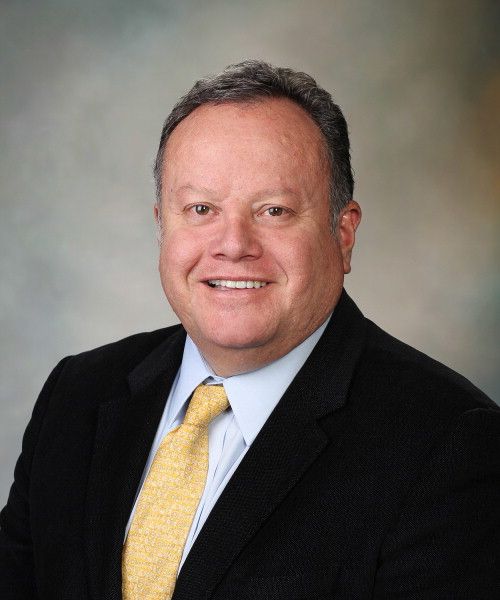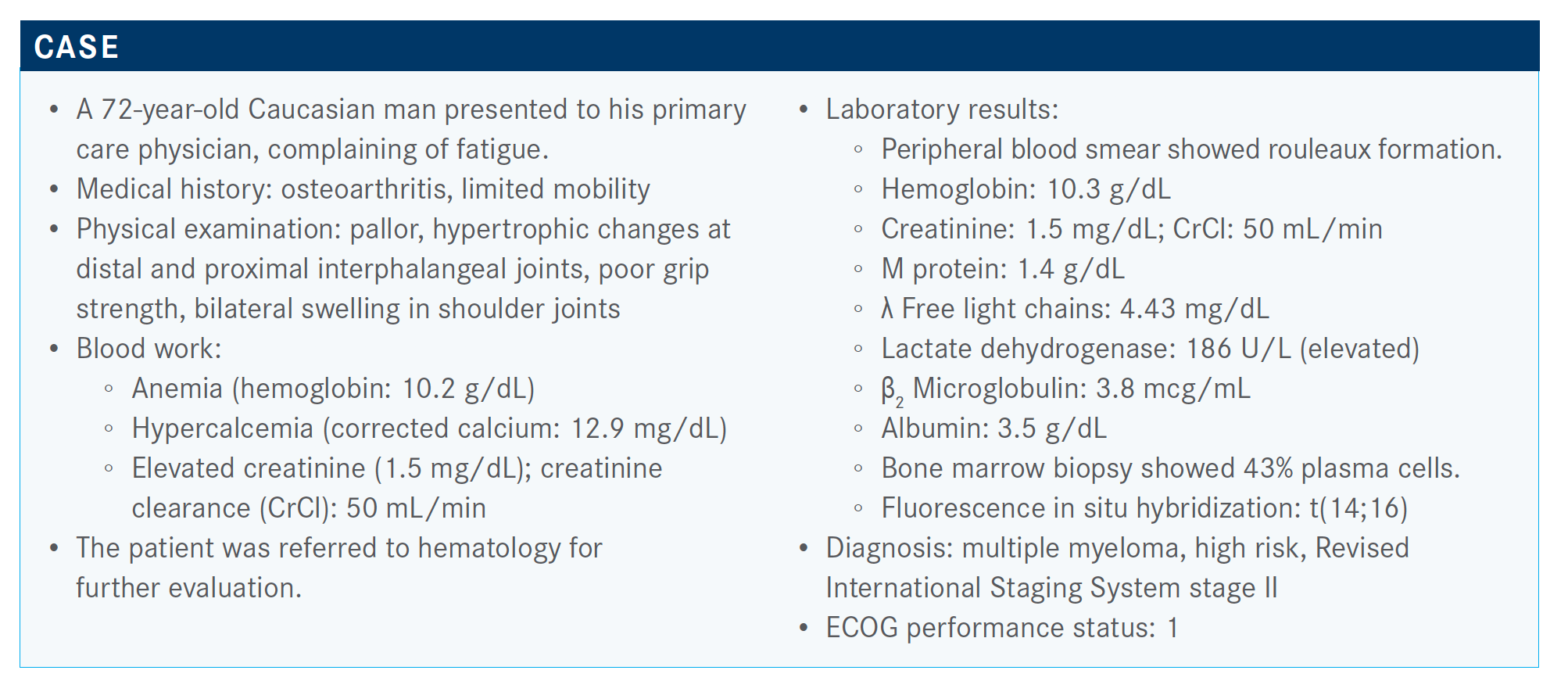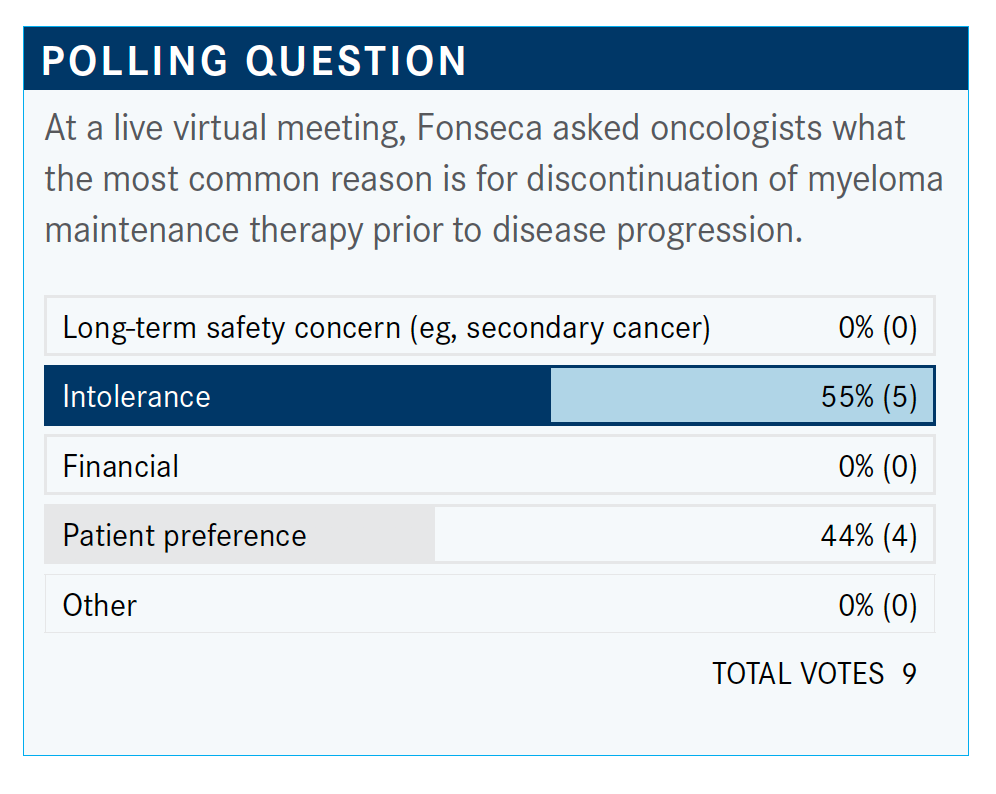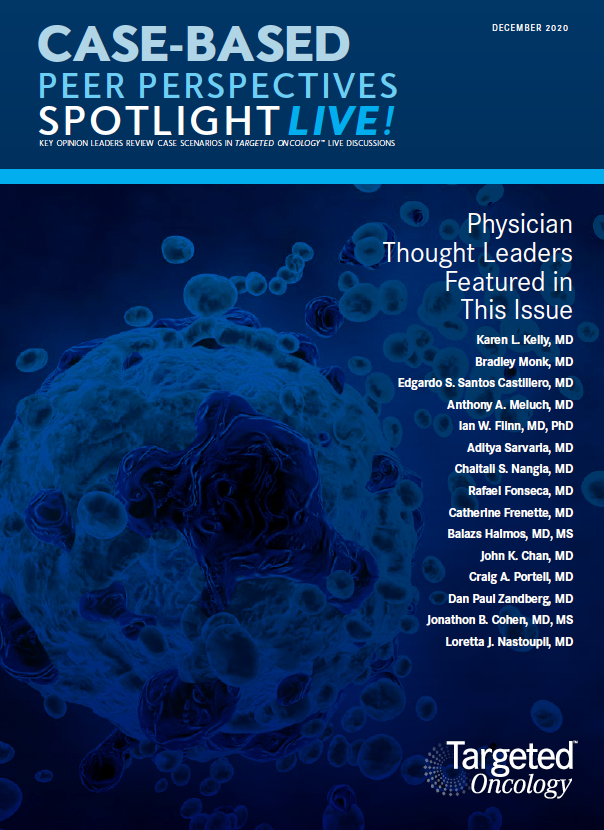Use of Daratumumab Suggested for Transplant-Ineligible Myeloma
During a Targeted Oncology Case-Based Peer Perspective event, Rafael Fonseca, MD, discussed the case of a 72-year-old patient with multiple myeloma.
Rafael Fonseca, MD

During a Targeted Oncology Case-Based Peer Perspective event, Rafael Fonseca, MD, interim director, chair, Department of Internal Medicine, and professor of Medicine at the Mayo Clinic Cancer Center, discussed the case of a 72-year-old patient with multiple myeloma.

Targeted OncologyTM: Which criteria do you use to define transplant eligibility?
FONSECA: We look at biologic age, we look at fitness of patients, their performance status, and organ function. I like to say that we [are able to] transplant patients who are on hemodialysis—we do the dose adjustment for melphalan—but renal failure is not a contraindication for transplant. [You] also have to make sure that they don’t have concomitant amyloidosis. We do [perform] transplant for these patients, but the approach is different for this patient population.
What are the guideline recommendations regarding treatment of this patient?
If you look at the National Comprehensive Cancer Network [NCCN] guidelines, I think there are a number of options. VRd [bortezomib (Velcade), lenalidomide (Revlimid), and dexamethasone] remains an option for this group of patients, but now we have the inclusion of the frontline preferred regimens of daratumumab [Darzalex], lenalidomide, and dexamethasone, or DRd, which could be an option for those who are frail. We still have CyBorD [cyclophosphamide, bortezomib, and dexamethasone] as well.1
One of the interesting things is about the ixazomib [Ninlaro] plus lenalidomide and dexamethasone regimen—which is a friendly regimen because of the all-oral component, particularly now with [coronavirus disease 2019]—is that there was a press release in March [stating] that the TOURMALINE-MM2 [NCT01850524] study did not meet the progression-free survival [PFS] end point.2 It’s something that could potentially be [considered], but it would be less likely to be a recommended regimen.
What clinical trial data support the approval of the VRd regimen?
Satisfying all the tenets of evidence-based medicine, the SWOG study S0777 [NCT00644228] of VRd versus Rd was a randomized phase 3 trial without the intention of to immediate stem cell transplant. [Induction therapy was] followed by maintenance, with the primary end point in this population being PFS.3
When you look at the results, PFS is in favor of the triplet [HR, 0.742; 96% CI, 0.594-0.928; P = .003]. Anyone who voted for that [in the poll] has strong evidence that it is an acceptable regimen for the treatment of this patient population. The same is true if you look at overall survival [OS], which was not reached [with VRd] versus 69 months [with Rd] for this population [HR, 0.709; 96% CI, 0.543-0.926; P = .0114].
If you look at toxicities…it comes down to the peripheral neuropathy [with VRd], which is still a factor. In this particular case, grade 3 or greater [neurologic] events were seen in about [one-third] of the patients. It’s something to keep in mind, particularly for this patient population that may have issues [such as] diabetes or other causes for neuropathy.
Do you ever use modified VRd?
There have been modified regimens trying to make VRd more tolerable. For the VRd light approaches, or modified VRd, there are a number of trials that have tested this. I think it’s fair to say most of them have concluded that the outcomes are similar [between regular VRd and the modified dose].4
One of the possibilities, and we can always adjust, is that we add more [to the dose] if they don’t respond. You can always up the doses and do adjustments. We’re fortunate to have such great markers in myeloma.
Are there recent data to support other NCCN-recommended regimens?
The MAIA clinical trial [NCT02252172] [addressed a similar] question as the SWOG study. But instead of using the bortezomib, they used daratumumab in transplant-ineligible patients. There was a 1:1 randomization of DRd versus Rd. The primary end point was PFS. It’s in an advanced age population, so a median of 73 years old, with a vast majority of them being over the age of 65.5
The study was positive in favor of the 3-drug combination.
The [median] PFS was not reached for the 3 drugs versus 31 months for Rd, and the 30-month PFS rates were 71% versus 56% [HR, 0.56; 95% CI, 0.4-0.73; P <.0001]. It’s too early to say anything about OS at this point. If you look at the responses, they were superior in favor for the 3-drug combination.
If you break these patients down by whether or not they’re able to achieve minimal residual disease [MRD]–negative status or not, you can conclude a few things. First of all, if they are MRD negative, the outcome is good. Now again, someone could say, “Well, this could be biology.” Sure, there’s a component, but patients were 3 times more likely to be MRD negative if they got 3 drugs [daratumumab plus Rd] versus 2 drugs [Rd], so the therapy does matter. And even for those who don’t achieve MRD, the 3 drugs are still beneficial. This study was clearly in favor of the 3-drug combination versus the 2 drugs. It’s an important development and an important step forward as we think about therapies for this patient population.
What are the safety concerns with the daratumumab-containing regimen?
There is a bit more as it relates to neutropenia, something we can manage. We know how to deal with that. When you look at other adverse effects, they seem to be similar. I think an important cautionary note [is that] our myeloma treatments are so good that I think they come with a bit of a double edge. They could create significant challenges with regard to infection. If you look at pneumonia, you see 14% versus 8% [of patients who experienced this in the DRd and Rd arms, respectively]. It’s not a big difference, but I think we have to be careful with infections in patients with myeloma. Sometimes when we see these regimens in relapsed/refractory myeloma or see patients who have IgG [immunoglobulin G] of less than 200 mg/dL with repeated infections, there’s something to keep in mind. Nevertheless, [these results indicated] acceptable rates of toxicity with DRd for frontline therapy.
Can you compare the results of trials for therapy in this patient group?
If you look at the best outcomes for all the regimens that we have available for transplant-ineligible patients, the best results we see are with MAIA and ALCYONE [NCT02195479]. A [remaining] question would be [related to] VRd. It has been a great regimen, but because of the results of what we have seen, we have now incorporated into the Mayo Clinic guidelines the MAIA regimen of DRd as a frontline option for patients who have newly diagnosed myeloma for this patient population.
We have consensus-based guidelines for [patients who are] transplant eligible. We try to update this with some regularity at mSMART.org. It doesn’t mean that everything we do and practice is related to this, but these are guidelines that we put out there as a myeloma group at Mayo [that] were supposed to [indicate what] we would be comfortable with people doing.6


Do you agree with this patient’s treatment course?
I use low doses of lenalidomide in combination with daratumumab. I often will use 10 mg or 15 mg, depending on the patient and their renal function. You can always adjust up, but I think we start at 25 mg. Not infrequently, you run into myelosuppression.
In my experience, intolerance [is the main reason to stop therapy]. Perhaps some of you think of this, too, as patient preference. The most common reason to stop could be hearing, “I’m just tired, I’m fatigued. The diarrhea is too much,” and the patients elect to stop therapy at some point.
References:
1. NCCN Clinical Practice Guidelines in Oncology. Multiple myeloma, version 1.2021. Accessed August 31, 2020. http://bit.ly/3hLBFKX
2. Takeda provides update on TOURMALINE-MM2 phase 3 trial. News release. Business Wire. March 10, 2020. Accessed August 31, 2020. bwnews.pr/2wOSXEi
3. Durie BGM, Hoering A, Abidi MH, et al. Bortezomib with lenalidomide and dexamethasone versus lenalidomide and dexamethasone alone in patients with newly diagnosed myeloma without intent for immediate autologous stemcell transplant (SWOG S0777): a randomised, open-label, phase 3 trial. Lancet. 2017;389(10068):519-527. doi:10.1016/S0140-6736(16)31594-X
4. Rodriguez C, Lantz J, Akbar F, Lantz J, Dressler E. Assessing efficacy and tolerability of a modified lenalidomide/bortezomib/dexamethasone (VRd-28) regimen using weekly bortezomib in multiple myeloma. Clin Lymphoma Myeloma Leuk. 2019;19(suppl 10):e217-e218. doi:10.1016/j.clml.2019.09.362
5. Facon T, Kumar S, Plesner T, et al. Daratumumab plus lenalidomide and dexamethasone for untreated myeloma. N Engl J Med. 2019;380(22):2104-2115. doi:10.1056/NEJMoa1817249
6. mSMART. Mayo stratification for myeloma and risk-adapted therapy: newly diagnosed myeloma. Mayo Clinic. Updated June 2020. Accessed August 31, 2020. http://bit.ly/2GiqcVD










